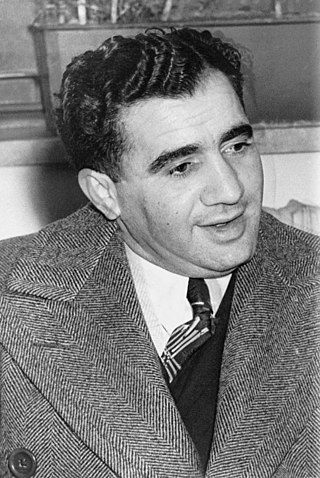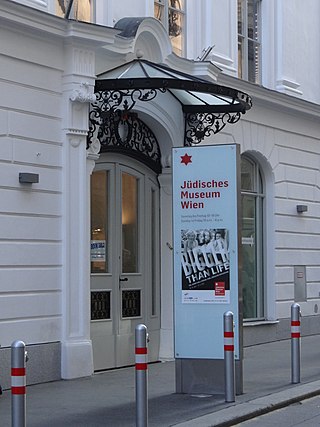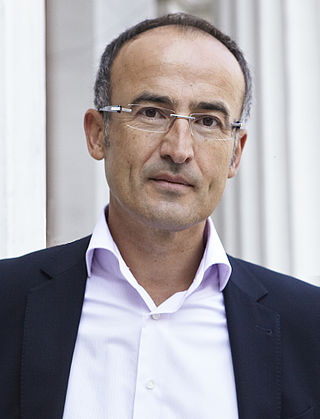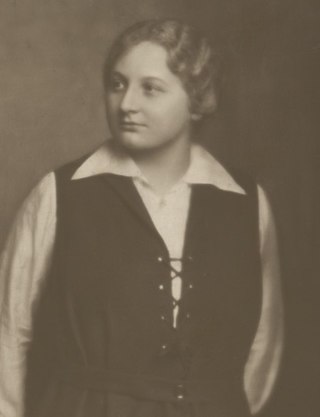Related Research Articles

Abraham "Kid Twist" Reles was a New York Jewish mobster who was a hit man for Murder, Inc., the enforcement contractor for Meyer Lansky's National Crime Syndicate.

Abner "Longie" Zwillman was a Jewish-American mobster who was based primarily in North Jersey. He was a long time friend and associate of mobsters Lucky Luciano and Meyer Lansky. Zwillman's criminal organization was a part of the National Crime Syndicate and mainly operated from the 1920s to the 1950s, with its peak in the late 1930s.
William Morris ("Willie") Bioff was a Jewish-American organized crime figure who operated as a Chicago pimp and corrupt union leader between the 1920s and the 1940s. Using his position as head of the movie production workers' union, Bioff helped Chicago Outfit boss Frank Nitti successfully extort millions of dollars from Hollywood film studios by using the threat of a general strike that would paralyze the American film industry.

"Big" Jack Zelig was an American gangster and one of the last leaders of the Eastman Gang.

Waxey Gordon was an American gangster who specialized in bootlegging and illegal gambling. An associate of Arnold Rothstein during prohibition, he was caught up in a power struggle following Rothstein's death. Fellow Rothstein associates Charles "Lucky" Luciano and Meyer Lansky provided authorities with evidence that led to his imprisonment for ten years.

Jacob "Little Augie" Orgen was a New York gangster involved in bootlegging and labor racketeering during Prohibition.

Jacob "Gurrah" Shapiro was a New York mobster who, with his partner Louis "Lepke" Buchalter, controlled industrial labor racketeering in New York for two decades and established the Murder, Inc. organization.
Muntean/Rosenblum is a collaborative artist duo composed of Markus Muntean and Adi Rosenblum. They have been collaborating since 1992.
Abe Bernstein was a Detroit-based Jewish-American organized crime figure and leader of the infamous Prohibition-era Purple Gang.
Jake "Greasy Thumb" Guzik was the financial and legal advisor, and later political "greaser," for the Chicago Outfit.

Stefan Hantel, better known by his stage name Shantel, is a German DJ and producer based in Frankfurt. He is known for his work with Romani brass orchestras, DJing and remixing traditional Balkan music with electronic beats.

Ingo Zechner is a philosopher and historian. He is the Director of the Ludwig Boltzmann Institute for Digital History (LBIDH) in Vienna.

The Jüdisches Museum Wien, trading as Jüdisches Museum der Stadt Wien GmbH or the Jewish Museum Vienna, is a museum of Jewish history, life and religion in Austria. The museum is present on two locations, in the Palais Eskeles in the Dorotheergasse and in the Judenplatz, and has distinguished itself by a very active programme of exhibitions and outreach events highlighting the past and present of Jewish culture in Austria. The current director is Barbara Staudinger and the chief curator is Astrid Peterle.

The Jewish Community of Vienna is the body that represents Vienna's Orthodox Jewish community. Today, the IKG has around 10 000 members. Throughout history, it has represented almost all of Austria's Jews, whose numbers are sufficient to form communities in only a few other cities in Austria.

Tobias G. Natter is an Austrian art historian and internationally renowned art expert with a particular expertise in "Vienna 1900".

Danielle Spera is an Austrian journalist, writer, and a former director of the Jewish Museum Vienna.
The Jewish Restitution Successor Organization Inc. was founded in 1947 in New York by various American and international Jewish organizations. Originally, it was incorporated on May 15, 1947, as the Jewish Restitution Commission, but in 1948 changed its name to the Jewish Restitution Successor Organization at the request of American military authorities.

Ludwig Blum was a Moravian-born Israeli painter. He emigrated to Israel in 1923, as part of the Third Aliyah, and became known as "the painter of Jerusalem".

Anitta Müller-Cohen born Rosenzweig (1890–1962) was an Austrian-born Jewish woman who emigrated to Tel Aviv, Palestine, in 1935. In Austria, she was a prominent social worker, politician and writer who became increasingly interested in Zionism. One of the leading members of Vienna's Jewish National Party, she organized and actively contributed to the First World Congress of Jewish Women which was held in Vienna in May 1923. At the American Jewish Congress in Chicago in 1925, she addressed the opening session. After emigrating to Palestine in 1935, she became a member of the Mizrahi Women's Organization, founded the Women's Social Service, and continued her welfare work which was mainly concerned with children and immigrants.
Hugo Haberfeld, was an Austrian Jewish art dealer, who owned the Miethke Gallery in early 20th century Vienna. When Austria joined Nazi Germany in the 1938 Anschluss, Haberfeld fled to Paris.
References
- ↑ GEBURT EINES MYTHOS http://bildung-beratung.wuk.at/bildung-beratung/event/id/17009
- 1 2 3 Maurer, Thomas; Oz Almog, Thomas Mauer; et al. (2000). "I'm an archivist not a moralist". Him too...?? Oz Almog's Concise Index Judaeorum. Jewish Museum Vienna. ISBN 978-3-901398-28-5.
- ↑ See exhibition catalog En Face (1995), publisher ISR, Vienna
- ↑ Almog, Oz (1997). Blood Addict. Institute of Strategic Research, Janko Dada Museum.
- ↑ Almog, Oz (1997). Shaheed. Institute of Strategic Research, Limbus Gallery Tel Aviv.
- ↑ "Die Ook – Oz Almog's beknopte Index Judaeorum". The Messis Foundation. 2001. Archived from the original on 24 July 2011. Retrieved 3 September 2010.
- ↑ Cahen, Joel; Oz Almog, Joel Cahen; et al. (2000). Magam hu[Him too...?? Oz Almog’s Concise Index Judaeorum] (in Hebrew). The Nahum Goldmann Museum of Jewish Diaspora. ISBN 978-3-901398-15-5.
- ↑ Steinberg, Shlomit; Oz Almog, Thomas Mauer; et al. (2000). "Spinoza, Kubrick, Gangster, Saviours". Him too...?? Oz Almog's Concise Index Judaeorum. Jewish Museum Vienna. ISBN 978-3-901398-28-5.
- ↑ The London Jewish Museum of Art (March 2003). "Him too..?? Oz Almog's Concise Index Judaeorum - A Chronicle of a Cultural Obsession". Archived from the original on 26 July 2011. Retrieved 31 August 2010.
- ↑ Joods Historish Museum (March 2003). "Die ook…?! Oz Almogs beknopte Index Judaeorum. Kroniek van een culturele obsessie" [Him too..?? Oz Almog’s Concise Index Judaeorum - A Chronicle of a Cultural Obsession] (in Dutch). Retrieved 31 August 2010.
- 1 2 Hadzivukovic, Vesna; Oz Almog (2010). "Oz Almog - Biography". Walls of Sound - Jewish Worlds of Music. Jewish Museum Vienna. ISBN 978-3-901398-55-1.
- ↑ "Art exhibit honors Soviet Jews". Kyiw News. 18 April 2002. Retrieved 3 September 2010.
- ↑ Grzegorz Sowula (18 May 2002). "Co Zachód wie o Wschodzie i na odwrót" [What the West knows about the East and vice versa] (in Polish). Rzeczpospolitej. Archived from the original on 16 April 2013. Retrieved 31 August 2010.
- ↑ American Jewish Year Book Vol. 104. American Jewish Committee. 2004. p. 406.
- ↑ Kosher Nostra – History of Jewish Gangsters in America 1890 - 1980 http://www.jmw.at/en/exhibitions/kosher-nostra-history-jewish-gangsters-america-1890-1980
- ↑ Federal Chancellery Austria (13 April 2004). "Jewish Museum Vienna: no less than three fascinating exhibitions" . Retrieved 3 September 2010.
- ↑ Julieta Rudich (13 January 2004). "Viena reconstruye la violenta historia de las mafias judías en Estados Unidos" [Vienna reconstructs the violent History of Jewish Mafia in United States]. El Pais (in Spanish). Retrieved 31 August 2010.
- ↑ Colors of War. A Warrior Cult http://www.jmw.at/en/exhibitions/colors-war-warrior-cult
- ↑ Oz Almog Walls of Sound - Jewish Worlds of Music (Vienna, Judishes Museum der Stadt Wien, 2010) in German/English, ISBN 978-3-901398-55-1
- ↑ Kosher Nostra: Jewish Gangsters Greatest Hits http://exclaim.ca/Music/article/oz_almog_shantel-kosher_nostra_jewish_gangsters_greatest_hits